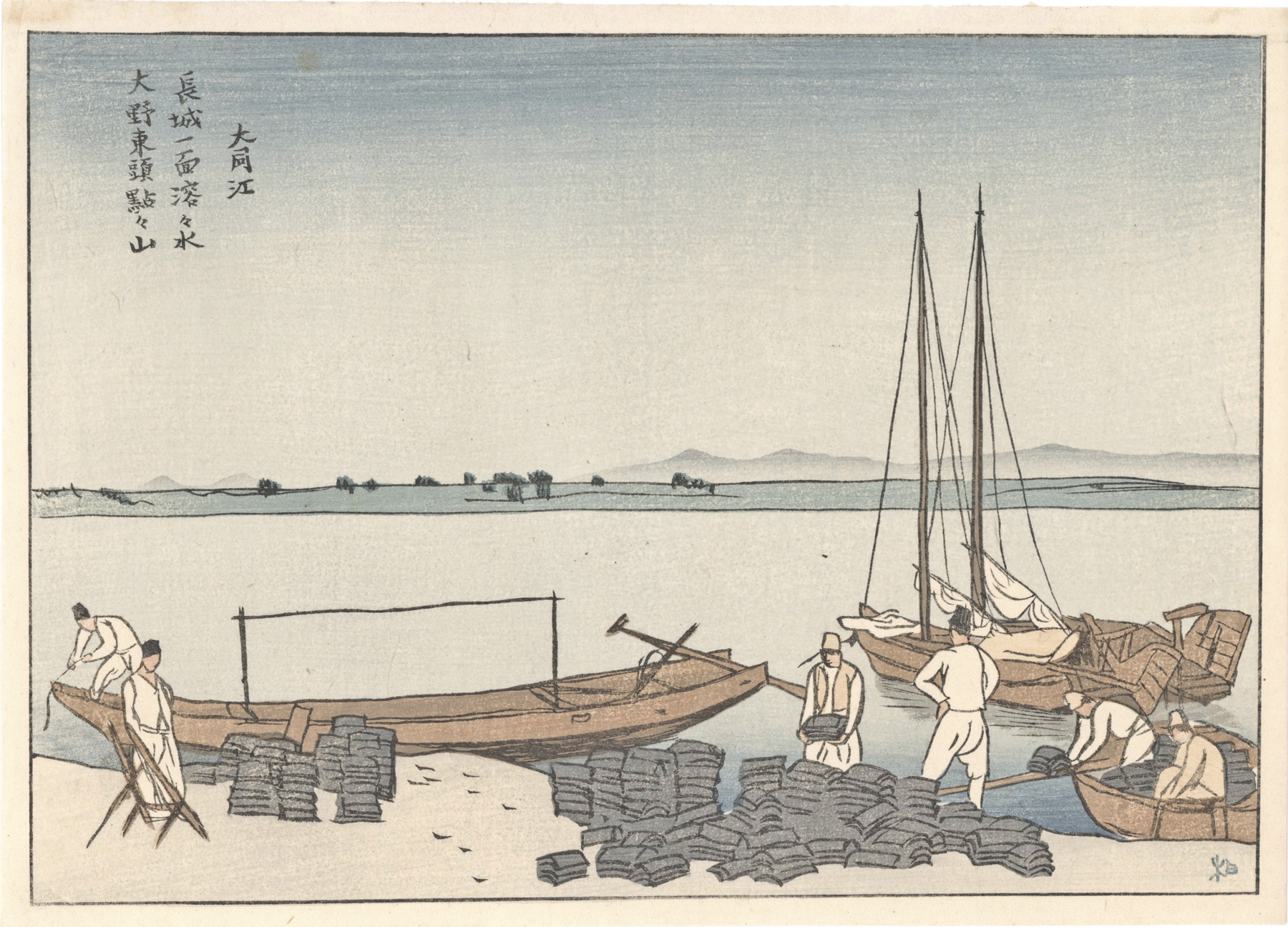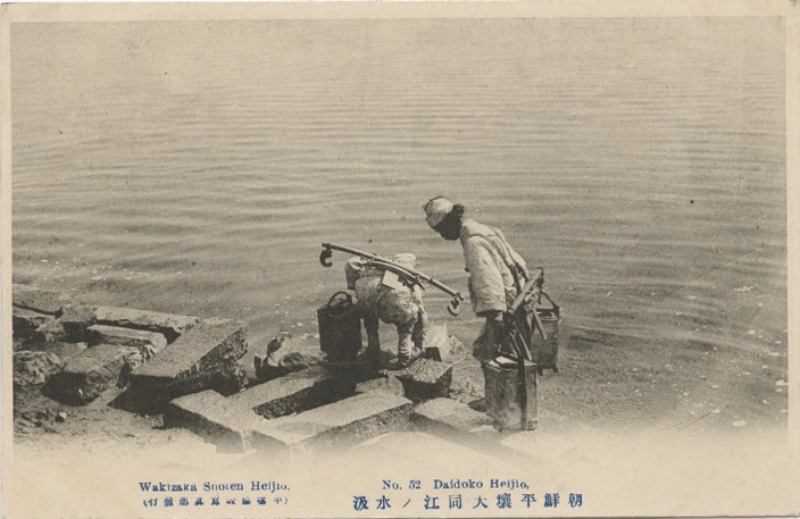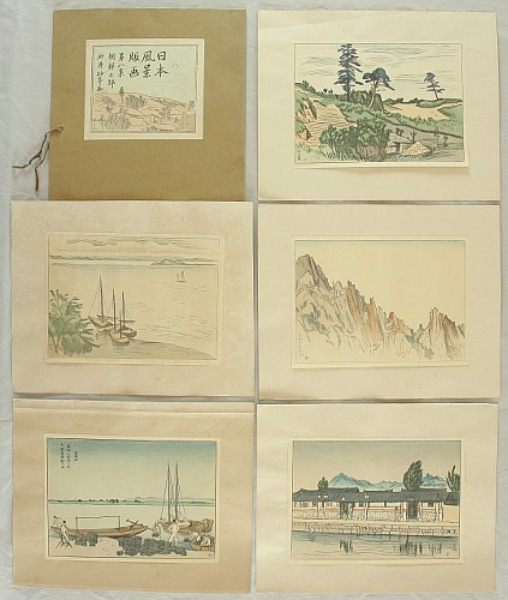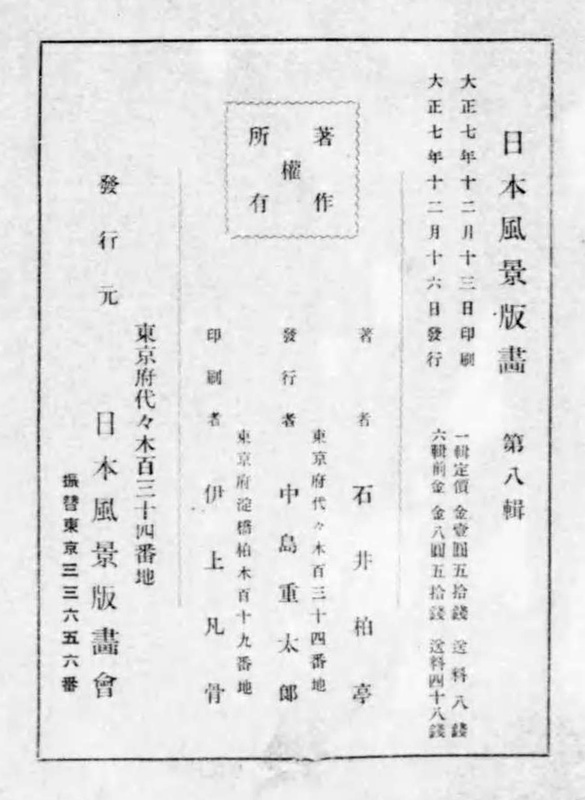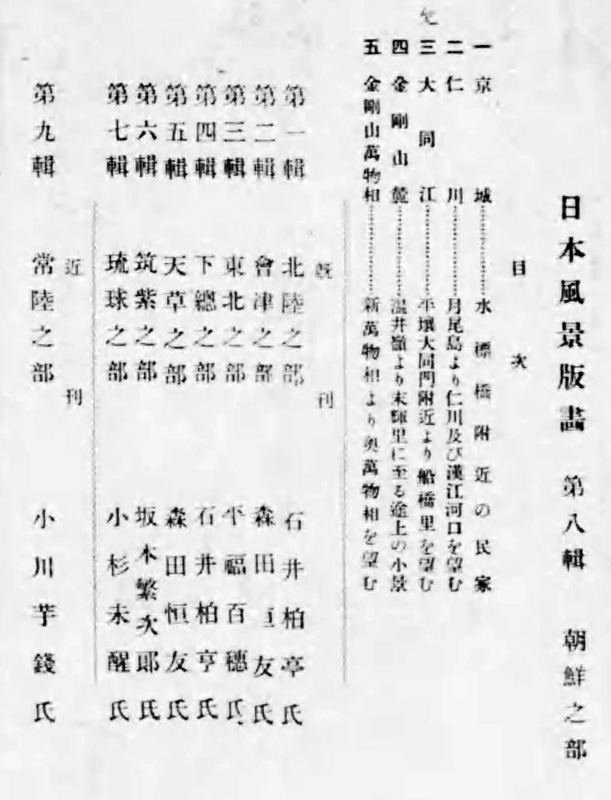About This Print
This print pictures laborers unloading what appear to be some type of tile from skiffs on the Taedong River in South Pyongan Province of North Korea. The print is titled 大同江 (Daidokō) or Daido Bay. It is one of 15 prints Hakutei contributed to the 50 print series published by Nakajima Jūtarō. (See "About the Series" below.)To the left of the title, the following verse in Chinese is inscribed:
長城一面溶々水 大野東頭點々山
[长城一面溶溶水,大野东头点点山 in simplified Chinese]
The foot of the moss-grown old rampart/Is washed by blue streams.
Dawn is breaking over the vast fields/And the rows of mountains.
The verse is attributed to the 11th century Koryo dynasty poet Kim Hwang Won (1045-1117) who, it is said, broke his brush and cried, as words failed him to describe the beauty of the view along the Taedong River.
Japan annexed Korea in August 1910 and occupied it until 1945. Hakutei visited Korea in 1910, as did other Japanese artists, to tour the area and exhibit his work in Seoul. As was the fashion, it is likely he participated in what came to be called "sketch tours" during his travels, and that the five prints he created in this Set 8 of the series, subtitled Korea, were based upon sketches he made during his visit.
A postcard ca. 1910 shows workers wearing similar clothing filling water containers along the river.
Daidoko Heijio [Pyongyang Taedong River]
朝鮮平壌大同江ノ水汲
Source: East Asia Image Collection, Lafayette College Libraries
About The Series Japan Scenery Prints
Source: Modern Japanese Woodblock Prints - The Early Years, Helen Merritt, University of Hawaii Press, 1998, p. 274-276.
"The series consisted of ten sets of prints. Each set was composed of five small landscapes and a cover print giving the name of the series, the name and number of the set, and the name of the artist. In addition, each set was accompanied by a table of contents and colophon sheet in standard type. Specific publication dates ranging from January 1917 through April 1920 indicate that each set was issued separately. Since Ishii Hakutei (1882-1958) designed a total of three sets while the other artists did one or two each, it seems likely that Hakutei was the spearhead for the project. The artists asked Igami Bonkutsu to carve the blocks and Nakajima Jūtarō to publish the series.
The Nihon fūkei hanga series was another experiment. . . in creating modern prints through the cooperation of carvers and printers. As they had done in the production of Hōsun, the artists put aside the self-carving/self-printing slogan. The main point, they reasoned, was that they were designing for woodblocks and supervising the carving and printing themselves.
Since there is no indication of the edition size, the artists may have intended to follow the usual Japanese publishers' practice of making as many as they could sell. The price is listed on each colophon sheet as one yen fifty-six sen for one set. A notation of postage or shipping cost was pasted onto some of the colophons suggesting that sets were distributed by mail and indicating that Nakajima Jūtarō had not anticipated the problem of postage and had to improvise a means to tell his customers of the extra charge. Hiratsuka Un'ichi (1895-1997), who helped with the carving of some of the late sets while he was studying with Igami Bonkotsu, recalled seeing advertisements for the series in small magazines.
Although the series was neither carved nor printed by the artists, it marked a significant step toward creative independence by shifting the initiative from the hanmoto [publisher] to the artists."
The Six Artist's Involved
In addition to Ishii Hakutei (1182-1958), the other artists who contributed to the series were Sakamoto Hanjirō (1882-1969) [see this collection's print Sea of Fire from the series Japan Scenery Prints], Hirafuku Hyakusui (1877-1933), Morita Tsunetomo (1881-1933), Kosugi Misei (1881-1964) and Ishii Tsuruzō (1887-1973), elder brother of Hakutei.
Volume 8: Korea
colophon
click on image to enlarge
Source: National Diet Library Digital Collections
http://dl.ndl.go.jp/info:ndljp/pid/967526
table of contents
click on image to enlargeThe list of print titles (right to left):京城 [Keijō (Seoul)]仁川 [Inchon]大同江 [Daidōkō]金剛山麓 [Mt. Kongō]金剛山萬物相 [Foot of Mt. Kongō]http://dl.ndl.go.jp/info:ndljp/pid/967526
Source: National Diet Library Digital Collections
Print Details
| IHL Catalog | #1183 |
| Title | Daido Bay (Daidokō 大同江) |
| Series | Japan Scenery Prints, Set 8: Korea (日本風景版画 第八集 朝鮮之部 Nihon fūkei hanga, dai-hachi shū Chōsen no bu) Note: Series is also seen translated as "Landscape Prints of Japan". |
| Artist | Ishii Hakutei (1882-1958) |
| Signature | unsigned |
| Seal |  |
| Publication Date | December 16, 1918 |
| Edition | first |
| Publisher | Nakajima Jūtarō 中島 重太郎 of the Japan Scenery Prints Association 日本風景版画会 [Marks: pub. ref. 368] |
| Carver | Igami Bonkotsu 伊上凡骨 (1877-1933) |
| Impression | excellent |
| Colors | excellent |
| Condition | exellent - slight rubbing and fold bottom left corner; remnants of mounting top margin; spot of foxing upper left in image |
| Genre | sosaku hanga (creative print); moku hanga |
| Miscellaneous | |
| Format | chuban |
| H x W Paper | 7 3/16 x 9 7/8 in. (18.3 x 25.1 cm) |
| H x W Image | 6 3/4 x 9 7/16 in. (17.1 x 24 cm) |
| Collections This Print | Carnegie Museum of Art 89.28.111.2, Harvard Art Museum 1978.224 |
| Reference Literature | Guide to Modern Japanese Woodblock Prints: 1900-1975, Helen Merritt, University of Hawaii Press, 1992, p. 264-265; Modern Japanese Woodblock Prints - The Early Years, Helen Merritt, University of Hawaii Press, 1998, p. 275; Modern Japanese Prints: The Twentieth Century, Amanda T. Zehnder, Carnegie Museum of Art, 2009, p. 56 |


